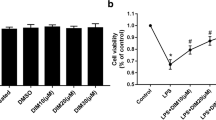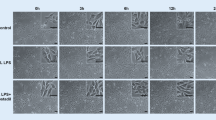Abstract
Growth factor independence 1 (Gfi-1) has been widely studied for its anti-inflammatory and anti-apoptotic effects. However, whether Gfi-1 has similar effects on H9c2 cardiomyocytes has not yet been reported. In this study, we explored the effect of Gfi-1 on lipopolysaccharide (LPS)-induced inflammatory responses and apoptosis in H9c2 cells. We found that LPS induced the increased expression of TNF-α and IL-6 in the LPS group. After transfection of the Gfi-1 overexpression plasmid, the expression of TNF-α and IL-6 decreased significantly in the LPS + Gfi-1 group. Gfi-1 clearly blocked LPS-induced NF-κB, TNF-α, TNFR1, cleaved-caspase-3 and cleaved-caspase-8 expression and increased Gfi-1 and Bcl-xL expression in H9c2 cells. Similarly, compared with the LPS group, Gfi-1 significantly decreased the expression of cleaved-caspase3/8 and increased the expression of Bcl-xL in the LPS + Gfi-1 group, as verified by immunocytochemical analysis. Furthermore, Gfi-1 markedly inhibited LPS-induced H9c2 cardiomyocyte apoptosis in the LPS + Gfi-1 group, as determined by TEM, TUNEL and flow cytometry. Taken together, these results demonstrate that Gfi-1 may have protective effects against LPS-induced inflammatory responses and apoptosis in H9c2 cells. Gfi-1 may be a novel molecule for treating septic cardiomyopathy.






Similar content being viewed by others
References
Seymour, C.W., V.X. Liu, T.J. Iwashyna, F.M. Brunkhorst, T.D. Rea, A. Scherag, G. Rubenfeld, J.M. Kahn, M. Shankar-Hari, M. Singer, C.S. Deutschman, G.J. Escobar, and D.C. Angus. 2016. Assessment of clinical criteria for sepsis: for the Third International Consensus Definitions for Sepsis and Septic Shock (Sepsis-3)[J]. Jama 315 (8): 762–774.
Perner, A., M. Joannidis, S. Opal, et al. 2017. Sepsis: frontiers in supportive care, organisation and research[J]. Intensive Care Medicine 43 (4): 496–508.
Charpentier, J., C.E. Luyt, Y. Fulla, C. Vinsonneau, A. Cariou, S. Grabar, J.F. Dhainaut, J.P. Mira, and J.D. Chiche. 2004. Brain natriuretic peptide: a marker of myocardial dysfunction and prognosis during severe sepsis.[J]. Critical Care Medicine 32 (3): 660–665.
Sanfilippo, F., C. Corredor, N. Fletcher, G. Landesberg, U. Benedetto, P. Foex, and M. Cecconi. 2015. Diastolic dysfunction and mortality in septic patients: a systematic review and meta-analysis. Intensive Care Medicine 41: 1004–1013.
Havaldar, Amarja Ashok. 2018. Evaluation of sepsis induced cardiac dysfunction as a predictor of mortality[J]. Cardiovascular Ultrasound 16 (1): 31–42.
Zhang, L., Y.L. Zheng, R.H. Hu, L. Zhu, C.C. Hu, F. Cheng, S. Li, and J.G. Li. 2018. Annexin A1 mimetic peptide AC2-26 inhibits sepsis-induced cardiomyocyte apoptosis through LXA4/PI3K/AKT signaling pathway[J]. Current Medical Science 38 (6): 997–1004.
Wang, Y.Y., Y. Wang, D. Yang, X. Yu, H. Li, X. Lv, D. Lu, and H. Wang. 2015. β1 -adrenoceptor stimulation promotes LPS-induced cardiomyocyte apoptosis through activating PKA and enhancing CaMKII and IκBα phosphorylation[J]. Critical Care 19 (1): 76–82.
Tupchong, K., A. Koyfman, and M. Foran. 2015. Sepsis, severe sepsis, and septic shock: a review of the literature[J]. African Journal of Emergency Medicine 5: 127–135.
Lv, H., Q. Liu, Z. Wen, H. Feng, X. Deng, and X. Ci. 2017. Xanthohumol ameliorates lipopolysaccharide (LPS)-induced acute lung injury via induction of AMPK/GSK3β-Nrf2 signal axis[J]. Redox Biology 12 (C): 311–324.
Thomas, R.C., M.F. Bath, C.M. Stover, D.G. Lambert, and J.P. Thompson. 2014. Exploring LPS-induced sepsis in rats and mice as a model to study potential protective effects of the nociceptin/orphanin FQ system[J]. Peptides 61: 56–60.
Sato, R., and M. Nasu. 2015. A review of sepsis-induced cardiomyopathy. Journal of Intensive Care 3: 1–7.
Balija, T.M., and S.F. Lowry. 2011. Lipopolysaccharide and sepsis-associated myocardial dysfunction[J]. Current Opinion in Infectious Diseases 24 (3): 248–253.
Hongbing, C., Z. Fan, and L. Zhen. 2018. Gfi-1 promotes proliferation of human cervical carcinoma via targeting of FBW7 ubiquitin ligase expression[J]. Cancer Management and Research 10: 2849–2857.
Jin, J., H. Zeng, K.W. Schmid, M. Toetsch, S. Uhlig, and T. Möröy. 2006. The zinc finger protein Gfi1 acts upstream of TNF to attenuate endotoxin-mediated inflammatory responses in the lung[J]. European Journal of Immunology 36 (2): 421–430.
Holger, K., Z. Hui, S. Thorsten, et al. 2002. Inflammatory reactions and severe neutropenia in mice lacking the transcriptional repressor Gfi1.[J]. Nature Genetics 30 (3): 295–300.
Liu, R., H. Jiang, Y. Tian, W. Zhao, and X. Wu. 2016. Astragaloside IV protects against polymicrobial sepsis through inhibiting inflammatory response and apoptosis of lymphocytes[J]. Journal of Surgical Research 200 (1): 315–323.
Watkins, S.J., G.M. Borthwick, and H.M. Arthur. 2011. The H9C2 cell line and primary neonatal cardiomyocyte cells show similar hypertrophic responses in vitro[J]. In Vitro Cellular & Developmental Biology Animal 47 (2): 125–131.
Jin, J., H. Zeng, K.W. Schmid, M. Toetsch, S. Uhlig, and T. Mo¨ro¨y. 2006. The zinc fifinger protein Gfi-1 acts upstream of TNF to attenuate endotoxin-mediated inflammatory responses in the lung. European Journal of Immunology 36: 421–430.
Sharif-Askari, E., L. Vassen, C. Kosan, C. Khandanpour, M.C. Gaudreau, F. Heyd, T. Okayama, J. Jin, M.E.B. Rojas, H.L. Grimes, H. Zeng, and T. Moroy. 2010. Zinc finger protein Gfi1 controls the endotoxin-mediated Toll-like receptor inflammatory response by antagonizing NF- B p65[J]. Molecular and Cellular Biology 30 (16): 3929–3942.
Khandanpour, C., C. Kosan, M.C. Gaudreau, U. Dührsen, J. Hébert, H. Zeng, and T. Möröy. 2011. Growth factor independence 1 protects hematopoietic stem cells against apoptosis but also prevents the development of a myeloproliferative-like disease[J]. Stem Cells (Dayton, Ohio) 29 (2): 376–385.
Qu, Xiaoling, Pia Nyeng, Fan Xiao, Jorge Dorantes, and Jan Jensen. 2015 Mar. Growth factor independence-1 (Gfi1) is required for pancreatic acinar unit formation and centroacinar cell differentiation[J]. Cellular and Molecular Gastroenterology and Hepatology 1 (2): 233–247.
Geissler, S., M. Textor, S. Stumpp, S. Seitz, A. Lekaj, S. Brunk, S. Klaassen, T. Schinke, C. Klein, S. Mundlos, U. Kornak, and J. Kühnisch. 2018. Loss of murine Gfi1 causes neutropenia and induces osteoporosis depending on the pathogen load and systemic inflammation[J]. PLoS One 13 (6): e0198510.
Ma, H., X. Wang, T. Ha, M. Gao, L. Liu, R. Wang, K. Yu, J.H. Kalbfleisch, R.L. Kao, D.L. Williams, and C. Li. 2016. MicroRNA-125b prevents cardiac dysfunction in polymicrobial sepsis by targeting TRAF6-mediated nuclear factor κB activation and p53-mediated apoptotic signaling[J]. Journal of Infectious Diseases 214 (11): 1773–1783.
Zhao, G., Y.M. Yu, M. Kaneki, et al. 2014. Simvastatin reduces burn injury-induced splenic apoptosis via downregulation of the TNF-α/NF-кB pathway[J]. Annals of Surgery 261 (5): 1006–1012.
Hayden, M.S., and S. Ghosh. 2008. Shared principles in NF-kappaB signaling.[J]. Cell 132 (3): 344–362.
Mussbacher, M., M. Salzmann, C. Brostjan, B. Hoesel, C. Schoergenhofer, H. Datler, P. Hohensinner, J. Basílio, P. Petzelbauer, A. Assinger, and J.A. Schmid. 2019. Cell type-specific roles of NF-κB linking inflammation and thrombosis. Frontiers in Immunology 10: 85.
Chand, H.S., J.F. Harris, and Y. Tesfaigzi. 2018. IL-13 in LPS-induced inflammation causes Bcl-2 expression to sustain hyperplastic mucous cells[J]. Scientific Reports 8 (1): 436.
Mckenna, S., B. Butler, L. Jatana, et al. 2017. Inhibition of IκBβ/NFκB signaling prevents LPS-induced IL1β expression without increasing apoptosis in the developing mouse lung:[J]. Pediatric Research 82 (6): 1064–1072.
Shou, Y., N. Li, L. Li, J.L. Borowitz, and G.E. Isom. 2002. NF-κB-mediated up-regulation of Bcl-XS and Bax contributes to cytochrome c release in cyanide-induced apoptosis[J]. Journal of Neurochemistry 81 (4): 842–852.
Zhong, L., X.L. Zhou, Y.S. Liu, et al. 2015. Estrogen receptor α mediates the effects of notoginsenoside R1 on endotoxin-induced inflammatory and apoptotic responses in H9c2 cardiomyocytes. Molecular Medicine Reports 12 (1): 119–126.
Liu, C., J. Lo, C. Kuo, et al. 2009. Akt mediates 17β-estradiol and/or estrogen receptor-α inhibition of LPS-induced tumor necresis factor-α expression and myocardial cell apoptosis by suppressing the JNK1/2-NFκB pathway. Journal of Cellular and Molecular Medicine 13 (9B): 3655–3667.
Funding
This work was financially supported by the Natural Science Foundation of Hubei Province [grant number 2018CFC847].
Author information
Authors and Affiliations
Corresponding author
Ethics declarations
Conflict of Interest
The authors declare that they have no conflicts of interest.
Additional information
Publisher’s Note
Springer Nature remains neutral with regard to jurisdictional claims in published maps and institutional affiliations.
Rights and permissions
About this article
Cite this article
Zheng, Y., Li, S., Hu, R. et al. GFI-1 Protects Against Lipopolysaccharide-Induced Inflammatory Responses and Apoptosis by Inhibition of the NF-κB/TNF-α Pathway in H9c2 Cells. Inflammation 43, 74–84 (2020). https://doi.org/10.1007/s10753-019-01095-x
Published:
Issue Date:
DOI: https://doi.org/10.1007/s10753-019-01095-x




